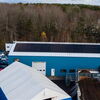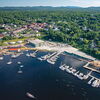
Acadia National Park visitors will be greeted by a new 'Gateway' welcome center
 Photo / Laurie Schreiber
The Acadia Gateway Center in Trenton, which opened last week, is the latest addition to Maine’s portfolio of mass timber construction projects.
Photo / Laurie Schreiber
The Acadia Gateway Center in Trenton, which opened last week, is the latest addition to Maine’s portfolio of mass timber construction projects.
In time for fall foliage season, the $27.7 million Acadia Gateway Center opened its doors last week.
The facility sits between Ellsworth and Mount Desert Island, the location designed to intercept traffic traveling south on Route 3 before arriving onto Mount Desert Island.
Owned by the state and operated by the Maine Department of Transportation in partnership with the Maine Office of Tourism, Acadia National Park and Downeast Transportation Inc., the center was designed to serve visitors to the Downeast region and Acadia National Park.
The project was funded by private and public support from Friends of Acadia, MDOT, the National Park Service and Federal Transit Administration.
Innovative construction material
The Acadia Gateway Center is the latest addition to Maine’s portfolio of mass timber construction projects.
“We had about 460 individual timbers in the timber frame,” Owen MacDonald, director of mass timber at New Energy Works in Farmington, N.Y., told Mainebiz. “It’s about 85,000 board feet of material.”
The center, at 42 Gateway Center Drive on the west side of Route 3 in the Hancock County town of Trenton, is an 11,000-square-foot building with a cathedral ceiling. Brewer-based Nickerson & O’Day Inc. was the general contractor.

A dominant construction feature is the use of mass timber, installed in 2024 by New Energy Works, whose core business is timber framing.
“We sent six guys,” said MacDonald. “They spent about nine days straight putting the timber frame up.”
In addition to the frame, the company used a “glulam” method of fabrication to make curved or “eyebrow” beams for the building’s entrance; and made the mass timber frame for the site’s bus stop and kiosk.
Other mass timber projects in Maine, in recent years, have included two buildings at College of the Atlantic in Bar Harbor, the Tekαkαpimək Contact Station at Katahdin Woods and Waters National Monument and two buildings at Bowdoin College in Brunswick.
Mortise-and-tenon
Destined for the Acadia Gateway Center, the massive timber frame was the largest to ever come through the company’s Farmington shop, MacDonald noted.

Solid timber framing and fabrication of glued members are each subsets of mass timber construction, he said.
In the case of the Acadia Gateway Center, most of the timber posts are 12-inch by 12-inch solid Douglas fir timbers, up to 42 feet long. The trees, typically harvested on the West Coast, were milled and shipped to the Farmington shop, where further fabrication and finishing were performed, then trucked 10 hours to Trenton.

Many timber-framing projects use metal-plate and bracket joinery. By contrast, the Acadia center features traditional wood joinery using mortise-and-tenon joinery and wood pegs. The mortise is an opening cut into one member and the tenon is a projecting piece cut into a second member for insertion into the mortise. Steel elements are embedded within the timbers to help handle the loads in the trusses, which cover large spans that provide an open feel that’s complemented by floor-to-ceiling windows on one end and glazing elsewhere.
Glulam
“Glulam,” or glued laminated timber, refers to multiple layers of lumber glued together with adhesive. The building’s eyebrow dormers were made of smaller boards that were bent and glued to an eyebrow radius, then joined into the timber frame.
“There’s a ton of complexity there, but it’s that focal point, you go, ‘Wow, look at that,’” said MacDonald.

The company sources timber from new-growth sustainably managed forests, he added. Elsewhere in Maine, it has a couple of residential projects, including one in Newry near Sunday River ski resort.
Mass timber is growing in demand, he said.
“We’re getting a ton of opportunities coming our way on the mass timber side,” he said. “A lot of them have to do with buildings in more urban areas, where you can add these mass timber floors on top of existing buildings because they don’t weigh as much as concrete and steel. They lower the building weight, so new buildings don’t have to have as complicated and extensive a foundation and concrete work.
Other sustainability features at the gateway center include a geothermal heating and cooling system, a rooftop solar panel array and electric vehicle charging stations.
Visitor facilities include free day-use parking, with 300 spaces including 18 electric vehicle charging spaces and 10 oversized vehicle spaces, a bus stop for Island Explorer and commercial tour buses, and an 11,000-square-foot information center with park and regional tourism information, retail space, restrooms and a waiting area.

Acadia National Park had 3.96 million visitors last year.
Monthly numbers for this year have been trending up. In August, Acadia had 842,827 visitors, compared with 795,332 during the same month last year, a 6% change; and 2,739,018 year-to-date, compared with 2,656,732 at the same point last year, a 3.1% change.
The August figure is a fair bit higher than 2015, with 666,767 visitors, and 2005, with 519,353 visitors.
June and July were also up. June had 631,333 visitors, compared with 599,015 the same month last year. July had 797,030 visitors, compared with 791,029 the same month last year.
In 2021, Acadia ranked No. 16 among most-visited national parks.














0 Comments